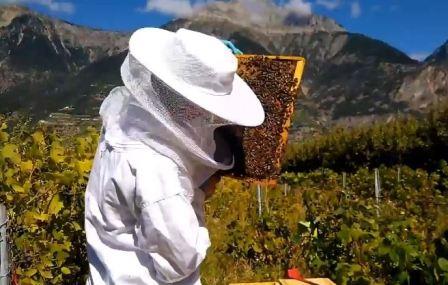Beekeeping in Switzerland

Switzerland (8.7 million people, 41.3 thousand sq. km) is a highly developed industrial country with a GDP per capita of more than $ 93.5 thousand. Intensive, highly developed agriculture has a livestock focus (production of milk and dairy products) and provides 56 - 57% of the food needs of the population of this country. Meadows and pastures occupy 75% of all land in Switzerland.
General characteristics of Switzerland and its beekeeping
An example is Swiss beekeeping. In terms of the density of bee colonies (4 per 1 km²), average honey consumption per person (1.2 kg per year) and other characteristics, Switzerland is ahead of other countries. Swiss beekeeping is developed throughout the country. Urban beekeeping has also developed significantly in recent years. From 2013 to 2018, the number of bee families in cities increased from 3,190 to 6,370. Organic beekeeping is also developing: in 2020, there were 5.1 thousand organic bee families in the country.
Unfortunately, limited territory, mountainous terrain and other factors hinder the further development of beekeeping in Switzerland. The number of bee colonies has not changed over the past 150 years, although the number of beekeepers has halved during this time. Until 1970, Swiss farmers were required to maintain apiaries on their farms. Currently, only 5% of farmers have bees.
According to official data, in 2022 there were 18.5 thousand beekeepers and 165 thousand bee colonies in Switzerland. Beekeeping is mainly a hobby. 80% of bees are kept in pavilions, 15% in Dadant hives and 5% in Sudak hives (multi-hull hives). The average apiary in Switzerland has 10 bee colonies. Only a few beekeepers have nomadic apiaries to obtain honey and pollinate crops, since bee colonies are evenly distributed throughout the country, which makes moving long distances irrational.
The main honey plants in Switzerland: acacia, chestnut, fruit trees, flowers and herbs of alpine meadows, dandelion, rapeseed.
Honeydew honey is also produced from coniferous and deciduous trees.
Registration of bee colonies in Switzerland is mandatory. The reason is the fight against American foulbrood and other dangerous diseases of honey bees. European foulbrood has become widespread in Switzerland.

The average annual honey production per bee colony is only 20 kg per year. However, if the weather is unfavorable, production drops significantly. For example, in 2020 this figure was 30 kg per hive, and in 2021 - 7 kg, and in 2022 - 24 kg.
Losses of bee colonies in Switzerland
Bee colony losses in Switzerland have been monitored since 2008. According to him, between 14.3 and 15.5% of bees have disappeared in recent years. After winter 2021/2022, Swiss beekeepers lost 21.4% of their bee colonies, and 15% of stems did not survive until spring 2023. However, losses in the summer season are usually 6.5-6.7%. It is also estimated that approximately 10% of bee colonies are so weakened after winter (despite having survived it) that they do not produce marketable honey during the season.
Bees of Switzerland
In 2014, 25,000 queen bees were raised in Switzerland, which belonged to the following breeds: Carnica (11 thousand), Central European (7 thousand), Italian (7 thousand) and Buckfast (2.5 thousand). However, in recent years, Swiss beekeepers have lost interest in the Italian bee and are instead increasing the number of Carnica and Buckfast bees in their apiaries. The number of Central European bees in apiaries is also growing.
Import of live bees
Switzerland is also a major importer of live bees – packages and queens. In 2017, 14.5 tons of livestock were imported. In 2021, Switzerland purchased bees from other countries for a total of US$0.5 million.
Asian hornet in Switzerland
A new threat to Swiss beekeepers is Vespa velutina, an Asian hornet that attacks bee colonies. The first nests of this hornet were discovered in 2017 and have since spread throughout the country. In 2022, high temperatures led to an acceleration in the spread of hornets.
